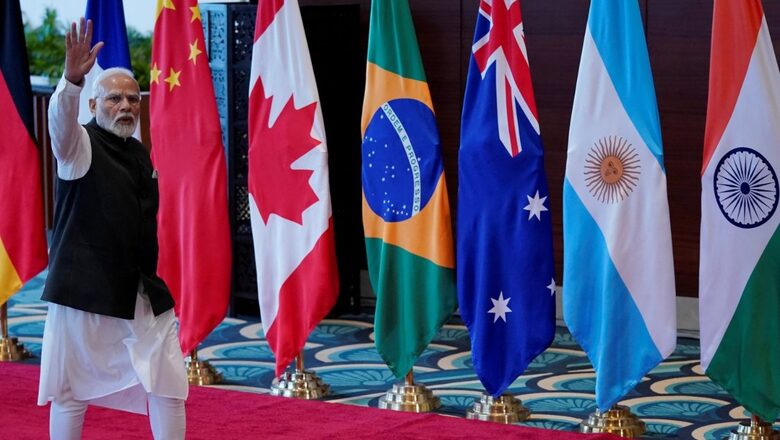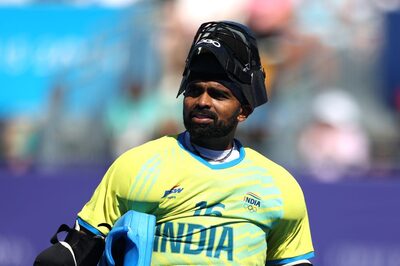
views
The PM Gati Shakti masterplan has revolutionised infrastructure development in India since its launch in 2021. Now, the government is planning to offer the PM Gati Shakti National Master Plan (PMGS-NMP) across the world, with an immediate focus on developing and underdeveloped countries. India has a plan to first offer PMGS-NMP to immediate neighbours like Bangladesh, Nepal and Sri Lanka for the planning and execution of certain cross-border infrastructure projects.
Subsequently, as India offers the plan to more and more countries around the world, a distinct product will also be developed for overseas projects, depending on the framework developed for domestic projects.
At the same time, India is also willing to offer such countries with limited access to the PM Gati Shakti portal, which will allow them to monitor projects from their inception right up to completion. Gati Shakti as a tool has been showcased to 30 countries in Central Asia and South East Asia so far.
The tool was also showcased at the recently concluded UN Economic and Social Commission for Asia Pacific (UNESCAP) conference in Hong Kong, at the Asia Pacific Business Forum, and the recent G20 meeting in Delhi. It is evident that the Centre is pushing the Gati Shakti masterplan at multilateral forums in a bid to market the tool’s potential to transform infrastructure development around the world. In fact, there is much interest within the international private sector as well, with companies looking to adopt the Gati Shakti plan to speed up projects and cut down unnecessary red tape.
India is offering PMGS-NMP to countries like Nepal, Bangladesh and Sri Lanka first keeping its “neighbourhood first” commitment in mind. Also, India partners with these countries frequently for connectivity projects, which is why utilising the Gati Shakti initiative to streamline their development can serve as a model for a host of countries.
The PMGS-NMP has in recent times emerged as a pivotal tool for India, in the sense that it streamlines and facilitates the seamless development of infrastructure projects. The programme is designed to create world-class infrastructure in the country that reduces the cost of logistics and enables efficient movement of goods and services. It was first announced by Prime Minister Narendra Modi on the occasion of the country’s 75th Independence Day with a whopping outlay of Rs 100 lakh crore. The goal was to provide multi-modal connectivity to more than 1,200 industrial clusters, including two defence corridors across the country.
As of August 2023, as many as 96 projects – each worth over Rs 500 crore and collectively worth Rs 5.80 trillion – have been assessed on the principles of PM Gati Shakti in 53 network planning group (NPG) meetings since the launch of the national master plan. Meanwhile, various key projects worth around Rs 108 trillion are at different stages of implementation under the National Infrastructure Pipeline (NIP).
Today, large-scale infrastructure projects like UDAAN, expansion of the railway network, Bharatmala, Sagarmala, inland waterways, and Bharat Net are being executed under the PMGS-NMP.
PM Gati Shakti enables multiple government departments to synchronise their efforts into a multi-modal network. Presently, 16 ministries such as Roads and Highways, Railways, Shipping, Petroleum and Gas, Power, Telecom, and Aviation are able to interact with each other as part of the plan, which is helping reduce both implementation time and cost. All the existing and planned initiatives of several ministries and departments are included on a single, central portal. With this, every department and ministry can see each other’s work, facilitating an “all of government” approach to achieve targets.
Gati Shakti also brings all relevant data under one umbrella with GIS-based spatial planning and analytical tools. Separately, satellite imagery provides on-ground progress periodically, which allows all ministries and departments to review, monitor and visualise the progress of cross-sectoral projects. The tech-savviness and sheer power of the masterplan could prove to be extremely beneficial for the developing world, and cement India’s position as not just the voice, but also the leader of the Global South.
India’s Foray into Global Infrastructure Development on the Horizon?
The offer to allow countries across the world access and make use of the Gati Shakti Masterplan has the potential to place India among the nations that are involved in global infrastructure development. PMGS-NMP will help New Delhi aid developing and underdeveloped countries to streamline their infrastructure-building processes and ensure that the best practices which are now helping India overcome a series of hurdles are also shared with countries around the world. This will truly make India a pioneer in infrastructure development. The idea that various countries can soon benefit from an idea and technology conceived entirely in India will further boost the country’s ‘Vishwaguru’ ambitions.
The fact that India is offering the Gati Shakti blueprint to its neighbours and subsequently to the world will also serve as a counter to China, which simply debt traps nations in the name of aiding their infrastructure development. Remember, China has revealed its intentions to take up 200 small-scale projects in the Indian Ocean Region, and that poses a threat to India’s interests.
So, the time for India to act is now, and the proposal to share Gati Shakti as a platform internationally can prove to be a significant method for India to establish itself as a country that actually helps nations develop and not debt-trap them. With PMGS-NMP in place across countries, it will be much easier for India to subsequently venture into the infrastructure development front to more comprehensively counter Beijing.
Views expressed in the above piece are personal and solely that of the author. They do not necessarily reflect News18’s views.


















Comments
0 comment